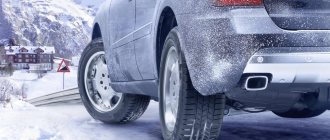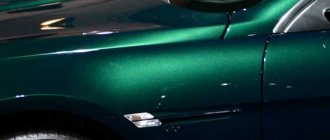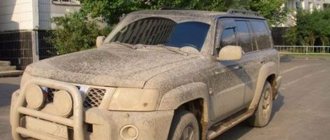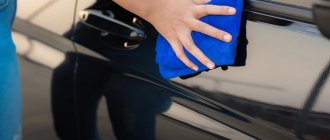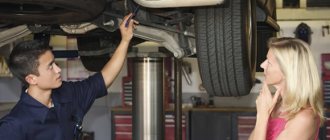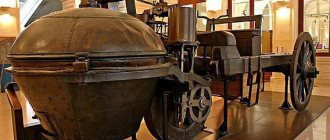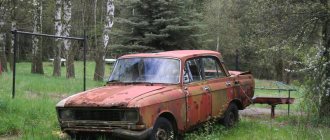CONSTRUCTIONS WITHOUT CUT
AUTO AUCTION CREDIT
ALL ABOUT JAPAN-TRADE
ATTENTION! FROM 25.03 IT BECAME POSSIBLE TO IMPORT CONSTRUCTION CONSTRUCTIONS WITHOUT CUT TO UNDER PTS ACCORDING TO THE OLD SCHEME.
The fee of 3,000 euros has been cancelled! The body is separated from the chassis and engine. Nothing is sawed, only minimal analysis!
If you need a donor for spare parts, it is better to bring the cut on ties, without assembly. This is cheaper than the designer by about 30,000 rubles.
What is a "constructor"?
— The car is dismantled to save on customs duties. The car is disassembled into the 1st configuration body, engine assembly and suspension. Nothing else is affected. Documents are issued: i.e. CCD (cargo customs declaration) for the body with a number, frame and engine. It is prohibited to drive such a car on public roads, but it can be transported using a tow truck. Delivery by the “designer” method is the most expensive, delivery by “carpil” and “cut” is much cheaper. Nowadays, only trucks and pickups are transported by designers; there is no point in ordering cars and jeeps from Japan by “constructors”. Firstly, due to the very high cost (1.5-2 times more expensive than “cutting-cuts”. Secondly, due to the difficulties in registration on the title. A designer is a car for your documents; without a title, operation is impossible .
What is “cutting a car”?
This is a car that is bought in Japan in its entirety. Then it is sawn in order to pay duty when imported into Russia as for spare parts, and not for the whole car. A cut is a car for your documents; without a title, operation is impossible. The car is sawed along the rear or the front. The roof pillars in the middle and the floor in the cabin are cut, the roof is not sawed.
For minibuses, the cut is carried out “figuratively”, from the front right door to the rear left (sliding) door through the engine compartment. Frame jeeps are sawed along the front or along the rear in the middle of the 4 roof pillars (in the area of the “dog walker” windows in the trunk) The frame is not sawed! The body is raised from the frame, on which the engine remains (unscrewed from the cushions) and the chassis.
Parts of the body are held together with ties, outwardly it looks like a whole car. It is even possible to move around a warehouse or parking lot with such a cut, the advantage of the cuts is that practically nothing can be disassembled from the machine. Then the car is assembled (welded) turnkey for further operation.
FIGURE CUT OF MINIBUSES:
The cut runs from the front right door through the engine compartment to the left side sliding door. Nothing can be taken apart except the casing, just sawing!
What is a "carpil auto"?
This is a car that is bought in Japan in its entirety. Then it is disassembled in order to pay duty when importing into Russia as for spare parts, and not for the whole car. Karpil is a car with your documents; without a title, operation is impossible. Only the front panel (TV, nouskat) is sawed. This does not affect the integrity of the body of your car from Japan. It also guarantees its continued safe operation. Not a single traffic police inspector will find seams on your body, because there simply aren’t any.
Partial disassembly of the car is carried out, the following are removed: - engine with automatic transmission
— headlights, grille, fenders (all doors, hood remain in place!)
It is not possible to import cabover minibuses (for example, old Mitsubishi Delica), as well as left-hand drive cars from Japan, with the exception of those that have Japanese analogues.
Why do customers buy car saws from Japan?
In case a person crashes his car and it cannot be restored. Or the car is rusty and in poor condition. Often the cost of spare parts and repairs is obviously higher than the price of sawing from Japan. It turns out that it’s easier to order a cut and “transfer” the necessary spare parts from it to your car. The remaining parts are sold or remain as spare parts. If the body cannot be restored, then there are other options. In this case, you will end up driving a car that came from Japan, but using your old documents.
Where do the documents come from for which it is possible to order a saw-cut?
These are documents from your old car, which cannot be restored, or was sold for spare parts. Also, documents with a frame or with an iron (bar) can be purchased on the Internet.
Why is it not profitable to buy a car from an “honest designer”, as before?
Firstly, at the moment it is very difficult and expensive to register an “honest designer”. Previously, it was much simpler, so there was a point in bringing it in like this. Secondly, previously, designers of the 1st configuration were not subject to a high duty of 3,000 euros per body, as is now the case. When importing by sawing or carving, no duty is paid for the body of the 1st configuration.
Why is it not profitable to buy a car with the front half?
Because the cost of delivery and customs clearance of halves from Japan is not much less than for cutting. But when you order a cut, you will also have the entire rear part of the car.
What machines are profitable to buy from Japan by sawing (cutting)?
In principle, any. Completely different cars fall into disrepair for various reasons. But we must keep in mind that even the cheapest car bought in Japan for $300-500 will cost 150,000 rubles in Vladivostok without assembly (varies depending on the dollar exchange rate).
Is cutting a car without assembly much cheaper? How much more expensive is carpil than sawing?
Cutting without assembly is 20,000 rubles cheaper. Carpiling is about $400 more expensive than sawing.
Can I choose a car one to one (color to color, body to body) to match my documents?
Yes, sure. All parameters of the car are specified in the application for the contract. Based on it, we carry out selection and purchase.
To whom will my cut (carpil) be sent from Japan? What kind of documents will I receive?
The cut (carpil) comes to a legal entity. The same company is a broker that will carry out customs clearance of the car. In the future, you will receive a purchase and sale agreement for numbered units (engine and frame). The remaining spare parts will also have customs documents (CCD), they are sufficient for transporting the car.
Do you have a high-quality assembly of cuts?
Yes, the assembly is high quality. The seams are additionally boiled and treated with an anti-corrosion substance. Duplications are made. All work is carried out by professional Russian craftsmen with at least 5 years of experience in similar work. The entire roof pillars are painted if they have been cut. Photo of the assembly cut for the title.
Do you have a high-quality assembly of carpiles?
Yes, the assembly is high quality. Interior and body parts are dismantled and carefully packaged in Japan. This avoids damage to spare parts during transportation. The assembly is carried out by qualified specialists, and as a result, your car is returned to the condition in which it was purchased at auction. Photo of the carpil assembly under the PTS.
I heard that sometimes designers lose various parts during delivery. As a result, you have to buy them at your own expense. Is it so?
- Yes, this happens occasionally. Our company is responsible for ensuring that your car is in full compliance with the condition at the auction when purchasing it in Japan. If during disassembly, transportation and assembly there is loss or damage to components, we will compensate for this at our own expense.
The car, probably, after complete disassembly to carpiling and assembly, will already resemble Russian rather than Japanese?
— We assure you that after assembly by our craftsmen, you will not be able to distinguish the car from a regular one. During everyday operation and repairs, the car is periodically subject to disassembly: for example, when installing an alarm system, dry cleaning the interior, repairing after an accident, replacing the engine. Having the proper experience in disassembling and assembling Japanese cars, the quality does not suffer after assembling the kit. What you can see when you accept the car.
Can you send a cut (carpil) of a car to the region without assembly?
Yes we can. In this case, the cut is not assembled; the front and back parts are attached to ties. The cut without assembly will look like this:
For carpil, sending without assembly is possible, but does not make any sense. Pallets with spare parts for carp saws are heavy and take up a lot of space. As a result, the transport company’s tariff for sending them will be similar to the cost of assembly, and may even exceed it.
Can you arrange a cut (carpil) or find documents for it?
Registration of cuts and karpilov on documents is impossible. They are ordered by those who have crashed their car and have a title and hardware (a strip with a body or frame number) in their hands. If you want to buy a cut (carpil) and you do not have the same wrecked car, then you can look for a title with iron among advertisements for the sale of documents. Thus, in the end you will be using a car that is already trouble-free, but with your old license plates and documents. Another option: all components and assemblies cut from Japan are installed on the body of an old car.
I have a frame, can I bring it to you, and you can assemble my construction set with it?
Yes, you can. You can bring us either the frame or your entire car. We will remove the old units from your frame and “put” new ones on it. We can also transfer all the units from your old car to a Japanese frame. As a result, you will take 2 cars from us, although one will be without documents.
How does this happen? Do I need to register a replacement with the traffic police?
Your frame is taken, then the engine, body, chassis, etc. are “put on” from a cut that came from Japan. The body of frame cars is not numbered, and the procedure for replacing the engine in the Russian Federation has been canceled. Therefore, there is no need to arrange for replacement units in this case. As a result, you will continue to move around using your old documents, but in a trouble-free car. Everything is absolutely legal, it will be possible to sell the car through an inspection at the traffic police.
What if my frame is in poor condition and it is impossible to install units on it?
In this case, it is better to use a Japanese frame, although you will need to install the necessary fragment from the frame of your old car into it.
Is it possible to order European left-hand drive cars (Mercedes, Audi) from Japan?
Yes it is possible. More often they are sold at auctions with right-hand drive, but there are also left-hand drive options. We recommend ordering such machines by cutting without assembly. The car will be delivered to your region on ties. It is possible to assemble and cut such a car in Vladivostok, or to deliver it by sawing (without cutting), but we cannot provide a guarantee for such work. The reason is the difficulty of assembling European cars, unlike Japanese ones.
I only need the engine, transmission and chassis (or body). Can you bring this separately?
No, we do not transport the body or the engine and transmission separately.
On our website you can CHOOSE AUTO-CARPIL AND CUT, prices are indicated in Vladivostok with assembly.
Low wages, high prices for spare parts, harsh operating conditions, low-quality fuel, bad roads and a number of other factors often lead to the fact that many cars, after another breakdown, are no longer practical to restore. Since many people simply do not have the funds to purchase a new car, the option of purchasing a cut or construction kit is literally the last available opportunity to drive a normal car. But, before starting a discussion of this issue, you need to understand what a cut and a designer are, how they differ, how not to accidentally “run into” such a car on the secondary market, and what pitfalls can await a person who decides to save a little money on buying a vehicle on secondary market.
Since January 2009, for cars that have been manufactured for 5 or more years, the amount of customs duties was significantly increased, which was immediately dubbed “barrier” by the people. Simply put, cars older than 5 years and with an engine capacity of more than 2 liters became simply unprofitable to import using the usual methods, so to circumvent these strict restrictions, cars began to be simply cut into pieces or disassembled, and then imported as spare parts.
What is a cutting machine?
Partial disassembly of the car, including sawing up the body and its subsequent transportation to Russia from abroad in order to reduce the cost of the vehicle. Importing foreign cars in this way allows you to significantly reduce the price of a car, which, in fact, is not a vehicle in the full sense of the word. This method of importing cars into the country makes it possible to save about 200 thousand rubles due to the absence of state duties.
Often, cutting is carried out in order to hide traces of accidents and other disasters that resulted in deformation and damage to the body. When cutting, no parts are removed: the wheels, engine and interior are kept intact. In comparison with the carp saw and the designer, the cut is the cheapest.
How to register a car
When a car arrives from abroad in the form of a set of components, the problem immediately arises of how to register such a designer car. To do this, you need a donor - the same model is not running - after an accident, fire, flooding, or simply faulty. The main thing is that the donor’s documents are in order.
The assembly is carried out in such a way that it looks like replacing various components on the donor with new ones with different numbers. After assembly, changes in the design are registered with the traffic police. This is the easiest way, but it is only possible if there are documents for new nodes with different numbers. Then, according to the documents, it will be an old car, but in reality it will be a completely new one.
In fact, this scheme is not working well now, since since 2012 there has been a decree prohibiting the registration of cars on which all license plates have been replaced at once.
How to register a construction car without a title from a donor? There are many difficulties here. If you write an application to register a car, you will be refused. Therefore, everything is decided through the court, as for a homemade vehicle. If the court finds it meets safety rules, it will issue permission for registration. This is a very difficult path, on which you will have to go through a lot of examinations and collect many different documents, as for all homemade products.
As you can see, to the question of whether it is possible to register a designer car, the answer is yes. But this is difficult if there is no PTS from the same model. In addition, it is becoming more difficult to import constructors - new laws are being introduced, for example, to impose duties on entire bodies. And it’s not so easy to get documents for them. Therefore, it is better to avoid such dubious savings - it can lead to many problems.
Karpil - what is it?
Carpiling means importing a car in a partially disassembled state: fenders, bumpers, doors are removed, the interior is completely cleaned and the transmission and engine are dismantled. The front part of the vehicle - the so-called "TV" - is also cut off. Despite the fact that both sawing and carpiling involve partial disassembly of the car, during carpiling the rigidity and strength of the body remains almost unchanged, which cannot be said about sawing, which involves sawing the body in half. It is almost impossible to visually determine what a carpil is: it is impossible to do this without disassembling the car, since there are no visible marks or seams left on the body. The cost of carpiling in comparison with sawing is much lower, so if you plan to purchase a car from abroad, then it is better to resort to carpiling.
Disassembly and assembly of saw cuts and kerfs from Japan are carried out by professionals, and therefore traces of sawing can be found on the car body only with the help of special instruments, for example, a thickness gauge. To avoid troubles with the car after cutting, the disassembly points are not only welded, but also reinforced with additional layers of metal, which increases the strength and rigidity of the body.
Advantages and disadvantages
Advantages:
- Price. Regardless of whether you drive a new car using the documents from the old one or use its spare parts on your car, it will cost two to three times less than a major overhaul, and the remaining spare parts can be sold and save even more.
- Quality. Cars in Japan are used much more carefully, and the quality of roads and infrastructure there is higher. Therefore, buying a cut is clearly a better solution than buying used spare parts one at a time in Russia.
Flaws:
- Cutting a car body smoothly and without deformation is not an easy task, but welding it back and making the seam invisible is the aerobatics of bodywork. It is impossible to do this work efficiently in artisanal conditions. A body deformation of a few millimeters can cause the car to constantly pull to the side. There are known cases of paint peeling off at welding points or body destruction while driving. Therefore, you need to contact only professionals who have special equipment (slipway).
- Dishonesty of some sellers. It is often impossible to check what condition the car was in before it was imported into the Russian Federation. Therefore, you have to rely on the honesty of car dealers. For the same amount, some will provide a car with perfectly preserved components, others will bring junk.
Read more: Gasket maker red instructions
The car can be assembled or become a donor of spare parts
What is a construction machine?
The constructor implies the complete disassembly of the vehicle into spare parts and their subsequent import into the country under the guise of scrap metal or individual spare parts, which allows you to save large sums on state duty. When importing a designer car, they do not resort to cutting the body. Those car owners who already have a legal vehicle with all the documents, but in poor condition, most often resort to purchasing a designer car. In such a situation, the designer acts as a donor, from whom the necessary components and parts are removed - for example, transmission, engine, attachments - and installed on another car. As a result, you can get a practically new vehicle at a lower cost.
How to check a car for cutting?
In practice, there are often situations when a sawing machine is passed off as a designer or its non-standard origin is not mentioned at all. You should not take the seller’s word for it and it is better to try to check the proposed vehicle yourself.
It is worth paying attention to a number of significant points:
- Price. The sawing is imported as spare parts at a low customs value, which makes it possible to sell the assembled car cheaper;
- Body pillars to which the roof is attached. It is along them that the cutting is carried out, and a weld seam may remain in the welding areas;
- Body painting. It is not always possible to choose the original shade, and the color of the paint may differ noticeably in places where it was cut);
- Mileage. Zero mileage or one that does not inspire confidence (the car is several years old according to the documents, but it has only been driven for a short time) will indicate that the car needs to be checked using databases.
You can avoid troubles when buying a foreign car secondhand by contacting specialists in this field who have the necessary tools to check the car.
The appearance of such machines
The increase in customs duties on the import of vehicles in 2009 provoked the emergence of similar, not entirely legal, schemes: in order to reduce customs taxes, cunning sellers and buyers began to dismantle cars and import them under the guise of scrap metal or spare parts.
Carpiling and sawing appeared in this business relatively recently. The popularity of cutting began to grow after the introduction in 2008 of a customs duty of five thousand euros for the first complete body. This innovation provoked sellers and buyers to think that importing a car in parts would cost several times less. The only problem was the difficulties with the registration of the body after import into the country, which means that sawing and sawing are profitable only if they are purchased for repair purposes as a donor. If such disassembled cars are purchased for the purpose of subsequent assembly and operation, then you will either have to pay duty in full for them, or break the law for the sake of imaginary benefit.
How to buy and register a designer car legally?
There are quite a few offers online to buy a used Japanese or European car without mileage in Russia at a reasonable price. Interest in such cars is justified: the build quality of cars and foreign roads is an order of magnitude higher than in Russia. But even here there are pitfalls and traps: sawing, the inability to register with the traffic police, as well as high rates of customs duties. What to pay attention to, what subtleties need to be taken into account when passing through customs, whether and how it is possible to legally legitimize and register a car designer in 2020, we will tell you in the article.
What to look for when purchasing?
First of all, on:
- The VIN number of the body and the engine number must be entered into the traffic police database.
- Welding places. Checked using a thickness gauge. However, you may encounter a situation where carpiling from Japan is such a painstakingly and professionally performed procedure in which all welding seams are made from the inside, so in order to get to them, you will have to remove the trim from the interior, which is far from agreeable every seller.
You can turn to specialists for help who will help you determine what it is - a cut, a cut, a designer or a full-fledged car with “clean” documentation.
You can evaluate a vehicle by the condition of the windows and door seals: if they look new, it means they have recently been changed, which may raise suspicions. If a car designer is transported across the border, then the windshield and rear windows are removed, respectively, their subsequent gluing may be of poor quality, which is immediately noticeable. It is advisable to check the glass numbers - they must match exactly. If there are differences or the seller does not agree to checks, then it is better to refuse the purchase.
You can assess the condition of the paintwork, check the engine compartment and door hinges - they should show no signs of recent painting or assembly.
Constructor and cut: what is the difference
Both options involve importing the vehicle in parts. The most relevant methods are for vehicles older than 5 years, since customs duty rates are increased for them. Each cubic centimeter of a small car engine up to 1 liter costs 3 euros. For a car under 5 years old, this figure is 1.5 euros. If you want a powerful Toyota Sequoia SUV with a 4.7-liter engine or a sporty Ford Mustang with a 5.8-liter engine, you will have to pay 5.7 euros per cubic centimeter. The option of buying a cut-up car or a construction set comes to the rescue. Japan is the exporting country. The main reason for purchasing a used foreign car in this way is the lack of mileage on Russian roads.
Documentation
Experts can say that carpiling is a type of constructor that, despite its relative legality, is still documented. When purchasing, the seller may provide the following documents:
- Customs declaration for the motor.
- Customs declaration for the body without the engine compartment.
- Purchase and sale agreement for purchased spare parts or scrap metal.
The listed documentation is sufficient to transport the purchased car using a tow truck.
What does car designer mean?
ATTENTION! FROM 25.03 IT BECAME POSSIBLE TO IMPORT CONSTRUCTION CONSTRUCTIONS WITHOUT CUT TO UNDER PTS ACCORDING TO THE OLD SCHEME.
The fee of 3,000 euros has been cancelled! The body is separated from the chassis and engine. Nothing is sawed, only minimal analysis!
If you need a donor for spare parts, it is better to bring the cut on ties, without assembly. This is cheaper than the designer by about 30,000 rubles.
What is a "constructor"?
— The car is dismantled to save on customs duties. The car is disassembled into the 1st configuration body, engine assembly and suspension. Nothing else is affected. Documents are issued: i.e. CCD (cargo customs declaration) for the body with a number, frame and engine. It is prohibited to drive such a car on public roads, but it can be transported using a tow truck. Delivery by the “designer” method is the most expensive, delivery by “carpil” and “cut” is much cheaper. Nowadays, only trucks and pickups are transported by designers; there is no point in ordering cars and jeeps from Japan by “constructors”. Firstly, due to the very high cost (1.5-2 times more expensive than “cutting-cuts”. Secondly, due to the difficulties in registration on the title. A designer is a car for your documents; without a title, operation is impossible .
What is “cutting a car”?
This is a car that is bought in Japan in its entirety. Then it is sawn in order to pay duty when imported into Russia as for spare parts, and not for the whole car. A cut is a car for your documents; without a title, operation is impossible. The car is sawed along the rear or the front. The roof pillars in the middle and the floor in the cabin are cut, the roof is not sawed.
For minibuses, the cut is carried out “figuratively”, from the front right door to the rear left (sliding) door through the engine compartment. Frame jeeps are sawed along the front or along the rear in the middle of the 4 roof pillars (in the area of the “dog walker” windows in the trunk) The frame is not sawed! The body is raised from the frame, on which the engine remains (unscrewed from the cushions) and the chassis.
Parts of the body are held together with ties, outwardly it looks like a whole car. It is even possible to move around a warehouse or parking lot with such a cut, the advantage of the cuts is that practically nothing can be disassembled from the machine. Then the car is assembled (welded) turnkey for further operation.
FIGURE CUT OF MINIBUSES:
The cut runs from the front right door through the engine compartment to the left side sliding door. Nothing can be taken apart except the casing, just sawing!
What is a "carpil auto"?
This is a car that is bought in Japan in its entirety. Then it is disassembled in order to pay duty when importing into Russia as for spare parts, and not for the whole car. Karpil is a car with your documents; without a title, operation is impossible. Only the front panel (TV, nouskat) is sawed. This does not affect the integrity of the body of your car from Japan. It also guarantees its continued safe operation. Not a single traffic police inspector will find seams on your body, because there simply aren’t any.
Partial disassembly of the car is carried out, the following are removed: - engine with automatic transmission
— headlights, grille, fenders (all doors, hood remain in place!)
It is not possible to import cabover minibuses (for example, old Mitsubishi Delica), as well as left-hand drive cars from Japan, with the exception of those that have Japanese analogues.
Why do customers buy car saws from Japan?
In case a person crashes his car and it cannot be restored. Or the car is rusty and in poor condition. Often the cost of spare parts and repairs is obviously higher than the price of sawing from Japan. It turns out that it’s easier to order a cut and “transfer” the necessary spare parts from it to your car. The remaining parts are sold or remain as spare parts. If the body cannot be restored, then there are other options. In this case, you will end up driving a car that came from Japan, but using your old documents.
Where do the documents come from for which it is possible to order a saw-cut?
These are documents from your old car, which cannot be restored, or was sold for spare parts. Also, documents with a frame or with an iron (bar) can be purchased on the Internet.
Carpil assembly
The karpil is assembled in accordance with all requirements and quality standards. Individual parts of the car are carefully removed and packaged in special material, which protects them from damage during transportation to other countries.
You can see in the photo that carpiling from Japan is a method of disassembling a car in which the interior is preserved and transported in its entirety. All its components - seats, upholstery, doors, airbags - are located in their places. Only the transmission, engine, chassis and “TV” can be disassembled. The car body is not sawn. The remaining components and parts of the car - headlights, bumpers and others - are carefully packed and left in the cabin.
The assembly of the carpil is carried out only by professionals, thanks to which all traces of welding of parts remain invisible.
Design car from Japan
The bottom line is this: a car is bought in Japan (70% of designers come from there), disassembled, that is, the engine is separate, the body is separate, and the chassis is separate. Then all this is transported to Russia in a disassembled state (as spare parts), the tax on such imports is several times less than if you were importing a whole car.
Next, we look for the same car, only broken down or less than a year old. Let's say you import a 2005 in a disassembled state, and yours is a 1990. Basically, all you need is documents. The next step is to replace components and assemblies on this old car. That is, you assemble a disassembled car and try to pass it off as an old one, but with new components!
After which you need to register all this with the traffic police. Let me remind you that now you can replace the main components, engine or body on any car, provided, of course, you have documents for new units.
And then it turns out that the car is from 1990, but in fact it is a car from 2005, registered under documents for an old car.
What does such a scheme provide? It’s simple, such a designer car will cost several times less than the same one, but cleared through customs according to the standard scheme. There were figures circulating on the Internet, the difference being approximately 50% of the cost.
Results
A car-cut, saw-cut or construction car is worth purchasing only if the car enthusiast knows exactly what he is getting into and buys a disassembled vehicle as a donor for restoring another car. If the carp is purchased for subsequent fraud with documentation and resale or independent operation, then it is better to refuse the purchase due to the fact that such transactions are illegal.
In addition, it is worth understanding the fact that cutting, unlike construction and carving, increases the risk of getting into an accident and subsequent death. The strength of a car body when it is cut is significantly reduced and no amount of welding or increasing the thickness of the metal, even the highest quality, will help restore it to the factory value. Accordingly, in the event of a collision, there is a high probability that the car body will simply fall apart. The chances of saving life and health in such a traffic accident for the driver and passengers are minimal, and saving money due to the purchase of a saw blade or saw blade does not justify such a risk.
Let's sum it up
Is it worth buying a saw cut, a carp saw, or a construction kit? It's worth it if you buy such a car consciously and understand what you're doing. I mean that your goal is to buy a cut-up car in order to take the necessary parts from there and update (restore) your car in this way. If you are going to buy a construction kit for further fraud with documents, for the subsequent sale of such a car or for its independent operation, I strongly do not recommend that you do this. Why? Yes because it is illegal! Selling such a car honestly will not work, nor will driving it yourself... So one way or another you will have to break the law. Now give yourself an answer to the question: “Do I need such problems?” I think the answer is obvious - “No!”
In addition, you must understand that sawing, unlike sawing and construction, is also a mortal danger in the event of an accident. If the cut car was cut, then one way or another the strength of the body was compromised, therefore, most likely, during an accident with a side impact, the car would simply fall apart into two parts. The chances of passengers surviving such an accident are almost zero.
That's all for me. Now you know what a cut is, what a karpil is and how they differ from a construction machine. Thank you for your attention and see you again at Question Auto.
Our company has been working in this direction since 2009. This kind of service will allow you to purchase a high-quality Japanese car absolutely inexpensively. In turn, our company guarantees you high reliability of its services. Our reputation is confirmed by numerous reviews from grateful clients. Contact us and we will help you buy a car in a short time and at reasonable prices!
Briefly about “cutting” - the car body is divided into 2 parts by cutting the body along the pillars of the windshield or rear window (luggage compartment) and the floor of the body. The location where the body will be cut is indicated by the client (at the rear or the front of the car). At the same time, the glass is removed, all the wiring passing through the cut points, as well as cables, hoses and tubes are removed and remain intact on one of the parts of the body. In a frame car, only the body is divided into parts; the frame remains intact. After customs clearance, the body parts can be welded together, the seams are sealed and painted over, or if the car is needed for spare parts, for ease of transportation, the body parts are fastened with metal plates - staples.
Delivery times for “cut”
Delivery time to Vladivostok from the date of purchase is 20-25 days, customs clearance 3-7 days, collection 4-7 days, delivery time to the region depends on the availability and occupancy of car transporters and travel time. Based on experience, the average delivery time for cuttings to the region is 1-2 months.
The process of disassembling and assembling, welding, painting the “cut”
Cars are dismantled and cut in Japan on shore in a workshop, or on a ship, as many companies do. Your car will be cut by professionals who have already cut thousands of cars. We have been collecting saw cuts since their inception and already have extensive experience in this area. Today, in our opinion, we provide the highest quality collection of saw cuts in Vladivostok. Our collection of cuts differs from collection in other companies in that: 1. All layers of metal are welded. Those. the cutting area is expanded and 2-3 layers of metal are welded (depending on the design of the car) 2. The welding areas are treated with an anti-corrosion agent; 3. Installation of additional rigidity at welding points. Simply put, additional iron is welded in, increasing the rigidity of the welding site; 4. The bottom of the weld is coated with sealant; 5. In the interior, the weld seam is covered with sound insulation or coated with sealant; 6. All necessary places are painted over. If you look at the car and don’t know that it’s a cut, then an “uninitiated” person is unlikely to find the welding spots. 7. Cars assembled from us do not fall apart or crack. So far we have not had any serious problems with any of the cars we have assembled. Many cars assembled from us have been driving everywhere in Russia for quite some time. Many cars are sent under their own power after assembly to other regions along our roads and are successfully operated in the future. And the test along the Vladivostok-Moscow route is significant proof of the quality of the collection.
What does the car know?
Parts that interfere with the disassembly of the car are removed and neatly stored in the car interior. Nevertheless, there are certain nuances; the car is still sawn and partially disassembled, so this must be taken into account. For example, when removing and transporting glass, it often breaks, so we are not responsible for the safety of the glass. During transportation, all the removed parts are put into the car’s interior. Of course, we try to put everything together as carefully as possible, but when our customs officers inspect the car, no one really stands on ceremony with the spare parts, and the glass can easily burst if the parts are rearranged in the cabin. There are also some car parts that cannot be removed without damaging them; these nuances depend on the car model. Therefore, please take into account that the car is being sawed and disassembled. Please note that we are not responsible for the absence or damage of spare parts as a result of disassembly and cutting.
The question is often asked: “can I cut differently?” In principle, you can cut it as you say, but you must understand that the existing cutting schemes were invented for a reason, but to cause minimal damage to the car and there were fewer problems during assembly. If you don’t need to assemble the car, but just need spare parts, then when ordering, please specify what exactly you want to receive. “Just sawing off the trunk” won’t work, customs won’t consider it a cut, so there’s no point in it.
LEAVE A REQUEST FOR A "CUTTING" CALCULATION
Please note that we do not process “cuts” for traffic police and do not sell PTS.
By ordering a cut from our company after customs clearance in Vladivostok, you receive the following documents: GCD (Cargo Customs Declaration) for the engine GCD (Cargo Customs Declaration) for the frame GCD (Cargo Customs Declaration) for the front and rear parts of the body DCP (Purchase Agreement) sales)
Savings on purchases
Communities DRIVE2 Perm region Blog Traffic rules 6.3 or 6.4
If you want to buy a car inexpensively without studying customs legislation and the rules for re-equipping vehicles, you should buy a construction kit from the person who previously imported it into the country. The only problem is that most owners prefer to remain silent about the purchase method, hoping to get a much larger amount of money
To recognize a car designer, you should pay attention to the following features:
- The paint on the bolts inside the body is damaged or applied unevenly;
- It is worth asking the car owner to show the purchase and sale agreement, in which the year of manufacture will differ from the year recorded in the title;
- A non-working air conditioner indicates disassembly of the car during transportation across the border - refilling the freon unit is quite expensive, so thrifty owners of construction kits often refuse such work;
- The designer's PTS records that the body has been replaced - this is a unique feature, since even when installing a new engine, such records do not always appear;
- Writing with a marker or markings with permanent nail polish at the junctions of individual units, for example, chassis components.
Many features will help you save on your purchase
The presence of one of the mentioned signs is a reason for a significant reduction in price, so when looking for them you need to be extremely careful. However, many owners of constructors carefully destroy all traces, which makes it impossible to recognize such a car. In addition, you may encounter a “cut”, which differs from the designer by the complete dismantling of the body, leading to a significant reduction in its strength. The optimal choice when buying a “cut” is a Japanese frame SUV, which does not lose strength when disassembling the body and does not require any special tricks for legal registration.
If you manage to recognize the designer and its previous owner is ready to give a significant discount, you don’t have to worry about further registration of the car. If it was previously registered in Russia, no problems should arise. However, there are often cases when the bodies and engines belong to a car that was stolen abroad and is wanted by Interpol. The consequences can be unpredictable - from fines and confiscation of vehicles to criminal liability for the purchase of such a designer. Therefore, before purchasing, it is worth ordering a full-fledged forensic examination, which will allow you to weed out illegal constructors at the initial stage.
What's wrong with cutting a car?
It makes a difference whether a framed or frameless car is sawn. In addition, if the body has a number, then this is an additional problem. In general, the biggest disadvantages of this method of transporting across borders are:
- To cut a frameless car, customs declarations will be issued for each part, including both halves of the body, but there will be no declaration for the whole body. Therefore, you will need to convert the number from another similar body to a new one, and then arrange for an engine replacement for the resulting car. All this is illegal and can lead to trouble.
- For a frame car, everything is somewhat simpler - they do not have a number on the body, and the declaration can be purchased from another similar body, imported into the country earlier. Because of this, frameless cars are most often imported from Japan - they are easier to register later.
- For a jeep, the cut is not critical - after good welding, reliability does not suffer, and you can drive such a car with peace of mind. The frame is the main load-bearing element here, and it is not sawed, so its strength does not suffer. But for frameless models, where the body itself serves as the main supporting structure, cutting is harmful. The reliability of such a car does not inspire confidence, and in the event of an accident, no one guarantees adequate safety for the people inside.
As you can see, for a lower price you can get a not very high-quality design, and this is not always a justified risk.
Principles of transportation and assembly
A constructor means a car that is completely disassembled for transportation across the border. According to customs legislation, a vehicle can be considered a spare part if the following have been removed from it:
- Engine;
- Chassis;
- Transmission;
- Exhaust system;
- Wheels;
- Fuel tank;
- Attachments.
In fact, a construction kit differs from a set of spare parts only in that individual units can be supplied assembled, but they must be separated from each other. It is also worth distinguishing between construction kits and assembly kits - only the wheels, engine, exhaust system and gas tank can be removed from the latter, but duties on them are reduced only if large-scale production is certified in Russia.
Knowing what a car designer is, it’s easy to guess that during customs clearance, the declaration indicates not a finished vehicle, but a set of components for it. In most cases, transportation of construction kits is carried out by special agencies that have agreements with customs, but sometimes buyers try to save money by transporting spare parts themselves. In such a situation, when asked by customs officers about the purpose of importing spare parts, it is necessary to answer that the components are supplied for the repair of a car located on the territory of the Russian Federation. Otherwise, the customs service may require you to register the purchase as a finished car. In this case, all that remains is to pay a large amount of money or turn the “constructor” into a “cut”.
The disassembly technology largely depends on the real purpose of importing the designer into the country. The largest number of cars are intended for subsequent re-registration by replacing units according to documents - in this case, the car is completely disassembled, and the front amplifier is cut off from the body so that it cannot be considered complete. If we are talking about a large frame SUV, the body of the designer can be sawn into several parts, since it does not have a big impact on the rigidity of the structure. The same is done when assembling according to all official rules with comprehensive customs clearance.
There is always the possibility of transporting the designer to repair a car, the spare parts of which are simply impossible to buy in the Russian Federation. In this case, the car does not have to be subsequently registered in accordance with all the rules, which significantly simplifies the procedure for passing customs control. In addition, the body of such a kit is most often sawn into many small components, which means that it is registered in the cargo customs declaration (CCD) as scrap metal with the payment of the appropriate duty. Interestingly, intermediaries take a lower commission percentage for transporting trucks and other commercial vehicles in this way than for transporting disassembled cars.
What to do if the purchased car has been cut
The purchase took place, but it turned out that the car was cut? This happens because the assembly can be of very high quality, and the buyer does not always have an expert on hand. Now the question arises whether it is possible to drive such a car and whether this will result in unexpected problems.
If the car is framed – usually jeeps – then there should be no problems with its safety and reliability. The frames are not sawed, and the structure does not lose its rigidity. A well-welded body should also not cause problems. Another thing is the documents, you need a title from the donor car so that the traffic police does not have problems during registration. In general, there are not many problems with sawn jeeps, especially Japanese ones.
Everything is much more serious with frameless models. Firstly, their body, which must absorb the entire impact force in an accident, has welds in places not intended by the designers, i.e. less reliable. Secondly, the case must have a number, which is difficult to replace, and even more difficult to complete all the documents. Registering such a car with the traffic police can be difficult, and sometimes impossible.
Finally, there are cases when such machines simply fell apart while moving at the welding site. Sometimes this happens even with a weak side impact. So saving can turn into a real danger to life.
What does sawing mean?
The auto-cutting business is widespread today; over the past year, the volume of deliveries of such vehicles from Japan reached 2,000 tons.
Let's look at what cutting a car is. In the manufacturing country, the car is cut up so that later, after customs clearance, the parts can simply be put together. The car is not disassembled, but rather carefully sawed. At customs it is submitted as scrap metal or auto parts, which saves money on duties.
On expensive jeeps, the front or back is cut off. Cheaper cars are simply cut in half, making sure not to disturb the seats and minimally damage the interior trim.
When delivered to the site after customs clearance, the parts are welded. Traces of welding work are masked. The seams are made inside the cabin, hiding them with trim. The outside is cleaned, puttied, the paint tone is selected and painted. Such a car is sold cheaper in order to sell it faster, while they are assured of its excellent condition.
How to determine the cut
Today the car market is so large that you can end up with unscrupulous car dealers. Without specialists, it is quite difficult to find out whether there is a cut in front of you. It’s best not to miss a cut when buying a car, contact a service station. However, sellers may waive a full inspection. Then there are several ways to find out the cut.
Determination of cut according to PTS
The cuts are delivered without a title; it is impossible to register such cars. If they are found driving illegally, the driver will be fined, their license may be revoked, and the vehicle will be taken to the impound lot.
Sometimes cutting machines are registered as a double, for an already existing registered machine. Then the owner of a genuine car may receive a fine issued in Rostov, although he himself did not travel further than the Moscow Ring Road. Doubles are usually found quickly and efficiently.
As a rule, initially the cuts do not have a PTS
The cut can also be passed off as a construction machine assembled from spare parts. However, sawing is more hazardous than construction due to damage caused to the chassis, electronics, and body.
To distinguish between the designer and the cut, you can “punch” the engine and body numbers on the Internet, checking when they were purchased. If it shows that the license plates are the same car, then the probability that you have a cut is high, since they assembled a “constructor” from parts of the same car.
Machine inspection
Check for seams and potholes in the rear door arches near the rear roof pillars; it is difficult to disguise the seams with paint. The seams are covered with putty and painted, but the new paint is visible in the sun, the cut cannot be restored perfectly, the paint is also difficult to match, the seams can be seen. Inspect the body for seams. Of course, it would be ideal to remove the trim from the interior ceiling. Since welding is done from the inside, the seams remain
But when you buy, the seller will not allow you to do this. Pay attention to the car's mileage; a zero reading is a warning signal. There is a thickness gauge device that determines additional putty and painting. Using it for problem areas: the area of the pillars, the front, the back - you will be able to detect traces of seams that can be perfectly polished, but the layer of putty and paint will be thicker, and it can be recognized with a thickness gauge. Check the interior floor
To hide the seams, new paint is used, and new sound insulation is installed. If the seller does not allow inspection, the car may have a problem. Check the condition of the rubber bands on the windows. If they are new, but cut and glued, this is a signal that helps determine the cut.
Of course, the low price is already suspicious. Moreover, when the sellers assure you that this is a completely new copy, exported from abroad, with low mileage.
When buying any car there is a risk, but cuts are a serious problem that leads to the death of those inside the car in an accident. Protect yourself and your loved ones.

